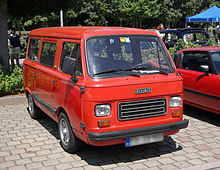Fiat 900T
| Fiat 900T | |
|---|---|
 | |
| Overview | |
| Manufacturer | Fiat |
| Also called |
|
| Production | 1976–1985 |
| Powertrain | |
| Engine | 903 cc I4 (petrol) |
| Dimensions | |
| Wheelbase | 2,000 mm (78.7 in) |
| Length | 3,750 mm (147.6 in) |
| Width | 1,520 mm (59.8 in) |
| Height | 1,740 mm (68.5 in) |
| Kerb weight | 835–900 kg (1,841–1,984 lb) |
| Chronology | |
| Predecessor | Fiat 850T Fiat 1100T |
| Successor | Fiat Scudo |
The Fiat 900T is a small van produced by the Italian automobile manufacturer Fiat between 1976 and 1985, replacing the similar Fiat 850T.[1] It was sold in the United Kingdom as the Fiat Citivan.
It was available in a number of variants, including the 900E seven seat minibus, and 900E camper vans called Amigo and Pandora.
Specifications[]

The 900T was powered by a rear mounted, four cylinder 903cc petrol engine, shared with the Fiat 127. In the 900T, it produced 35 bhp (26 kW; 35 PS) at 4,500 rpm and 44.84 lb⋅ft (61 N⋅m) at 3,300 rpm.[2] The 900T was equipped with small 12” wheels, and had a small turning circle of 29 ft 6.5 in (9.00 m).
The van was fitted with drum brakes all around. The standard van’s luggage compartment could hold 2,650 L (93.6 cu ft).
Models[]
The 900E minibus was discontinued without a direct successor in 1981. Fiat kept producing the cargo versions until 1986, as Japanese microvans and trucks took over this market segment. Production continued at Zastava's Kragujevac plant until 1989 or 1990. Zastava's 900 was available as a van (AK), pickup (F), double cab pickup (AF), or minibus (AL).
Fiat did not produce pickups at the time so third party coach builders, such as the well known Zagato, Viotti, specialists of Satae Ghiae, like Fissore, Moretti, Orlandi, Vignale, Coriascoe Pasino would purchase 900T vans from the factory of Fiat and convert them into campers and pickups, similar to the versions by Volkswagen.
These companies cut away the rear body, added panels as needed to complete the conversion, and then resprayed the original colour.
Coriasco and Fissore stamped the rear of the body with their own vehicle identification number to the right of the original Fiat VIN, which were then combined into one longer vehicle identification number on the title. The pickup version was very similar to the Volkswagen Combi, with raised rear bed, removable bed walls and large storage area accessible from either side underneath.
References[]
- ^ "HISTORY: Working alongside professionals for over 100 years". Fiat. 20 August 2013. Retrieved 20 August 2013.
- ^ Citivan leaflet. Fiat UK. 1978. Retrieved 20 August 2013.
| Wikimedia Commons has media related to Fiat 900. |
- Fiat vehicles
- Vans
- Vehicles introduced in 1976
- 1970s cars
- 1980s cars
- Rear-engined vehicles
